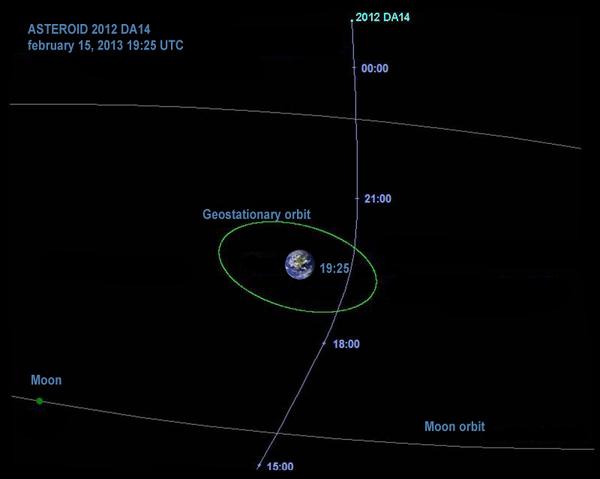
This time, we saw it coming towards us as early as February 2012, and astronomers were able to detect it before its passage. Asteroid 2012 DA14 has a modest size of 45 meters and a mass of 135,000 tons. It approached Earth on February 15, 2013, at 19:24 (UTC).
Since the beginning of the near-Earth asteroid detection program, this asteroid is the largest object to come so close to Earth. The distance is still sufficiently large to pose no danger of collision, astronomers have indicated. It will pass closest to Earth at 27,700 kilometers, which is a very small distance on the scale of the solar system; the Moon is 360,000 km away.
Many small rocky bodies called asteroids are present in the solar system. A significant portion of them circulate in a ring between the orbits of Mars and Jupiter, between 2 and 4 AU, in what astronomers call the asteroid belt or main belt. It thus marks the boundary between the terrestrial planets and the gas giants.
An asteroid is a celestial object not visible to the naked eye due to its small size, which varies from a few tens of meters to several hundred kilometers in diameter. Objects smaller than 50 m in diameter, like asteroid 2012 DA14, are called meteorites. "On average, an asteroid of this size comes as close to Earth every forty years and risks colliding with our planet every twelve hundred years," said Donald Yeomans, director of the Near Earth Object (NEO) office at NASA's Jet Propulsion Laboratory.
An asteroid is classified as a near-Earth object if its size is greater than 152 meters and its distance is less than 7.5 million kilometers from Earth. It is important to note that, although these objects are qualified as "potentially hazardous," this does not mean that a collision with Earth is imminent or certain. Astronomers actively monitor these objects to calculate their future trajectories and assess the real risks they pose. NASA has already cataloged 9,500 potentially hazardous small celestial bodies, which is one-tenth of the total.
A 45-meter-diameter asteroid entering the atmosphere at a very shallow angle (a few degrees) will not succeed in passing through the atmosphere and will cause no damage. It will simply bounce off the Earth's atmospheric layer and return to space. This occurred on August 10, 1972, in the sky over Montana in the northern United States. However, if it falls vertically, its size is sufficient to cause damage on the scale of a department. An object 50 meters in diameter creates a gigantic crater like the famous Meteor Crater in Arizona. In comparison, a 1 km meteorite would create a 20-kilometer-diameter crater and kill 2 to 3 billion people due to the tsunami triggered on a hemispheric scale. The probability of this happening is once every 150,000 years.
The meteorite responsible for the extinction of the dinosaurs, which fell in the Gulf of Mexico 66 million years ago, measured 10 kilometers in diameter.
| Asteroids | Approximate dimensions |
Discovery date |
| Ceres 1 | 974.6 km | 1801 |
| Pallas 2 | 582×556×500 km | 1802 |
| Vesta 4 | 572.6x557.2x446 km | 1807 |
| Hygiea 10 | 530x407x370 km | 1849 |
| Sylvia 87 | 384x262x232 km | 1866 |
| Hektor 624 | 370x195x195 km | 1907 |
| Europa 52 | 360x315x240 km | 1858 |
| Eunomia 15 | 357x355x212 km | 1851 |
| Davida 511 | 357x294x231 km | 1903 |
| Interamnia 704 | 350.3x303.6 km | 1910 |
| Camilla 107 | 344x246x205 km | 1868 |
| Juno 3 | 320x267x200 km | 1804 |
| Cybele 65 | 302x290x232 km | 1861 |
| Hermione 121 | 268x186x183 km | 1872 |
| Euphrosyne 31 | 255.9 km | 1854 |
| Chariklo 10199 | 248x258 km | 1997 |
| Iris 7 | 240x200x200 km | 1847 |
| Psyche 16 | 240x185x145 km | 1852 |
| Daphne 41 | 239x183x153 km | 1856 |
| Kalliope 22 | 235x144x124 km | 1852 |
| Amphitrite 29 | 233x212x193 km | 1854 |